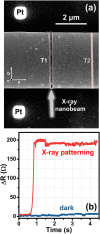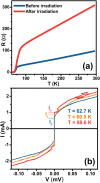Maskless X-Ray Writing of Electrical Devices on a Superconducting Oxide with Nanometer Resolution and Online Process Monitoring
- PMID: 28831111
- PMCID: PMC5567384
- DOI: 10.1038/s41598-017-09443-3
Maskless X-Ray Writing of Electrical Devices on a Superconducting Oxide with Nanometer Resolution and Online Process Monitoring
Abstract
X-ray nanofabrication has so far been usually limited to mask methods involving photoresist impression and subsequent etching. Herein we show that an innovative maskless X-ray nanopatterning approach allows writing electrical devices with nanometer feature size. In particular we fabricated a Josephson device on a Bi2Sr2CaCu2O8+δ (Bi-2212) superconducting oxide micro-crystal by drawing two single lines of only 50 nm in width using a 17.4 keV synchrotron nano-beam. A precise control of the fabrication process was achieved by monitoring in situ the variations of the device electrical resistance during X-ray irradiation, thus finely tuning the irradiation time to drive the material into a non-superconducting state only in the irradiated regions, without significantly perturbing the crystal structure. Time-dependent finite element model simulations show that a possible microscopic origin of this effect can be related to the instantaneous temperature increase induced by the intense synchrotron picosecond X-ray pulses. These results prove that a conceptually new patterning method for oxide electrical devices, based on the local change of electrical properties, is actually possible with potential advantages in terms of heat dissipation, chemical contamination, miniaturization and high aspect ratio of the devices.
Conflict of interest statement
The authors declare that they have no competing interests.
Figures





Similar articles
-
Direct-Write X-ray Nanopatterning: A Proof of Concept Josephson Device on Bi2Sr2CaCu2O8+δ Superconducting Oxide.Nano Lett. 2016 Mar 9;16(3):1669-74. doi: 10.1021/acs.nanolett.5b04568. Epub 2016 Feb 3. Nano Lett. 2016. PMID: 26814601
-
Doping change in the Bi-2212 superconductor directly induced by a hard X-ray nanobeam.Nano Lett. 2014 Mar 12;14(3):1583-9. doi: 10.1021/nl404834u. Epub 2014 Mar 3. Nano Lett. 2014. PMID: 24568635
-
Aluminum oxide mask fabrication by focused ion beam implantation combined with wet etching.Nanotechnology. 2013 May 3;24(17):175304. doi: 10.1088/0957-4484/24/17/175304. Epub 2013 Apr 9. Nanotechnology. 2013. PMID: 23571491
-
Precise slit-width control of niobium apertures for superconducting LEDs.Nanotechnology. 2011 Jan 28;22(4):045302. doi: 10.1088/0957-4484/22/4/045302. Epub 2010 Dec 20. Nanotechnology. 2011. PMID: 21169663
-
Superconducting Materials and Devices Grown by Focused Ion and Electron Beam Induced Deposition.Nanomaterials (Basel). 2022 Apr 15;12(8):1367. doi: 10.3390/nano12081367. Nanomaterials (Basel). 2022. PMID: 35458074 Free PMC article. Review.
Cited by
-
Antimicrobial Activity of MgB2 Powders Produced via Reactive Liquid Infiltration Method.Molecules. 2021 Aug 17;26(16):4966. doi: 10.3390/molecules26164966. Molecules. 2021. PMID: 34443553 Free PMC article.
-
Creation of pure non-crystalline diamond nanostructures via room-temperature ion irradiation and subsequent thermal annealing.Nanoscale Adv. 2021 Jun 9;3(14):4156-4165. doi: 10.1039/d1na00136a. eCollection 2021 Jul 13. Nanoscale Adv. 2021. PMID: 36132848 Free PMC article.
References
-
- Seisyan RP. Nanolithography in microelectronics: A review. Tech. Phys. 2011;56:1061–1073. doi: 10.1134/S1063784211080214. - DOI
-
- Romanato F, et al. Fabrication of 3D metallic photonic crystals by X-ray lithography. Microelectron. Eng. 2003;67-8:479–486. doi: 10.1016/S0167-9317(03)00104-7. - DOI
-
- Maldonado JR, Peckerar M. X-ray lithography: Some history, current status and future prospects. Microelectron. Eng. 2016;161:87–93. doi: 10.1016/j.mee.2016.03.052. - DOI
-
- Cerrina F. X-ray imaging: applications to patterning and lithography. J. Phys. D-Appl. Phys. 2000;33:R103–R116. doi: 10.1088/0022-3727/33/12/201. - DOI
Publication types
LinkOut - more resources
Full Text Sources
Other Literature Sources
Research Materials

